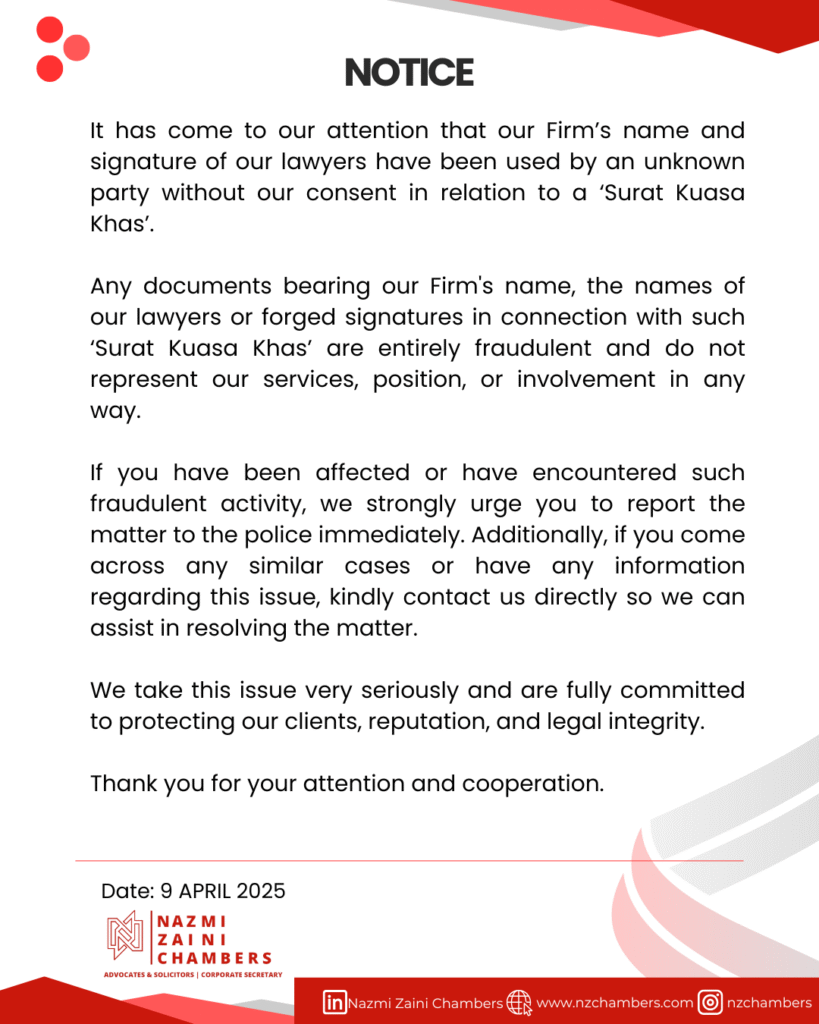Pure Economic Loss In Construction Defects: The Malaysian Perspective
Introduction
Before we go into the substance of the aforementioned subject hereinbelow, it is important to first understand what is means by “pure economic loss”. In this respect, the Federal Court of Malaysia has given some guidance as to its meaning:-
- “pure economic loss is financial or pecuniary loss that does not arise from any physical damage to the person or property”[1]; and
- pure economic loss is “financial loss suffered by a plaintiff, due to the negligence of the defendant which does not arise from any physical damage to his person or property”[2].
Further, the learned author Teng Kam Wah in his book entitled ‘Construction Defects Claim in Malaysia’[3] suggests that “pure economic loss is financial loss resulting from a loss in value of the property itself”. The learned author further distinguishes between “pure economic loss” and “economic loss”, the latter being a “financial loss which flows from personal injury or damage to property other than the property itself”.
In the context of the construction industry, cases of pure economic loss for defects typically arises where there are latent defects in a building which has been sold or transferred ultimately from the developer, onwards to several chain of purchasers (e.g first purchaser, second purchaser, third purchaser etc). Latent defects are usually only discovered much later post-completion of the construction of a building – hence, the party at fault may not be the party that the purchaser is in contract with and therefore, such purchaser has to look for a claim in negligence e.g claims for pure economic loss.
The Position in the UK & The US Summarised
In the United Kingdom, the leading case authority on claims for pure economic losses in cases of construction defects is the case of Murphy v Brentwood District Council[4], where the House of Lords inter alia held that where a defect was discovered before any injury to personal health or damage to property other than the defective house itself had been done, the expense incurred by a subsequent purchaser of the house in putting the defect right was pure economic loss[5].
In this case, the plaintiff purchased a property, but 11 years later it began to subside as a result of defects in the footings. The plaintiff was unable to afford the required repairs to the defects and was forced to sell the property at a loss (he received £35,000 less due to the defects). He claimed damages against the defendant (a local authority) citing the defendant’s negligence in approving the plans for the footings of the property and also claimed damages for the health and safety risk which the defects had caused to the plaintiff and his family during the time they lived at the property.
In its decision, the House of Lords decided that as the damage suffered by the plaintiff was neither material nor physical but purely economic, the defendant was not liable in negligence. It was decided that to allow the plaintiff to recover damages for the money which he had lost on the sale of the property, or for the cost of repairing it, would result in an unacceptably wide liability which would effectively amount to judicial legislation introducing product liability and transmissible warranties for defective buildings. In other words, the Court held that pure economic loss is irrecoverable in tort.
Across the seas, in the United States, the ‘complex structure theory’ was developed through the case of Quackenbush v Ford Motor Co[6] where the Supreme Court of New York inter alia held that the plaintiff could recover damages in tort from the manufacturer for damage to her motor car resulting from an accident due to faulty brakes. This theory essentially provides “that a complex chattel or structure might be considered as being formed of separate constituent parts and one part, when it caused damage to another part of the same structure or chattel, may be regarded in the law of tort as having caused damage to “other property consistent” with the Donoghue v Stevenson principles”[7]. This position was unlike the position in the UK and essentially allowed tortious claims for pure economic loss.
However, this theory has since been rejected namely through the case of East River Steamship Corp v Transamerica Delaval Inc[8], where the United States Supreme Court inter alia held that “pure economic loss is essentially the failure of the purchaser to receive the benefit of his bargain which traditionally the core concern of contract law”.
The Courts in the UK had considered the ‘complex structure theory’ as well but generally found that it was an impractical approach in determining claims for pure economic loss and maintained that Murphy (supra) remains the leading position on tortious claims for pure economic loss.
The position in Malaysia
The law surrounding pure economic loss in construction defects has historically been regarded as an unsettled area in Malaysia. This concept made its first debut in the case of Kerajaan Malaysia v Cheah Foong Chiew[9] (“Cheah”). In the case of Cheah, the plaintiff sought damages for negligence against the defendants, who were employees of the consulting firm responsible for superintending and supervising construction carried out by Sri Kinabalu Sdn Bhd. The plaintiff contended that all three defendants failed to carry out their duties to superintend and supervise the construction, causing the plaintiff to suffer substantial losses in repairing the buildings in order to make them safe for occupation.
As discussed above, the UK Court held that pure economic loss is irrecoverable in tort according to the English case of Murphy v Brentwood District Council.[10] The Court further held that the assistant resident engineer owed no direct duty to the plaintiff, and was only responsible to the firm, Sigoh Din Sdn Bhd. The said engineer could not be held liable under tort as there was no injury to any person or damage to the property of another as a result of his act of misconduct.
This rationale was reaffirmed in the subsequent case of Teh Khem On & Anor. v Yeoh & Wu Development Sdn. Bhd. & Ors[11] (“Teh”), where the court concluded that claims for pure economic loss against architects and engineers were similarly irrecoverable in the absence of any direct contractual relationship between the parties.
However, in 1998, the High Court in the case of Dr Abdul Hamid Abdul Rashid & Anor v Jurusan Malaysia Consultants & Ors[12] (“Jurusan”) marked a significant departure from the precedents set by Cheah and Teh. In Jurusan. The Court allowed a claim for pure economic loss based on policy reasons. The Court acknowledged that the debate over allowing claims for pure economic loss centers on two main viewpoints: the potential for creating liability ‘for an indeterminate amount for an indeterminate time to an indeterminate class’, which they fear could lead to excessive claims with vague parameters in terms of amount, time, and class of plaintiffs, potentially resulting in uncertainty and “endless indeterminate liability”.
In tackling the concerns of Indeterminate Liability, the presiding judge, James Foong J (as His Lordship then was) in Jurusan resolved that :-
- for indeterminate amount, such concerns are largely unfounded as in all pure economic loss cases, the amount of damages claimed is not an amount which could not be determined;
- for indeterminate time, the principle of “reasonableness” as discussed in Bryan v Maloney[13] can effectively limit the liability for pure economic loss, by ensuring that the damage must be foreseeable, and a duty of care must be present.
- for indeterminate class, His Lordship held that in situations such as that in Bryan v Maloney (supra), there is an assumption of responsibility by the builder and likely reliance by the owner. Would it then be foreseeable that any defect in the building will lead to pure economic loss being suffered by the owner, whether first or subsequent.
Even though Jurusan’s decision was later overruled by the Court of Appeal in the case of Arab-Malaysian Finance Bhd v Steven Phoa Cheng Loon & Ors and Other Appeals[14], the position of law is maintained where pure economic loss is recoverable subject to the foreseeability test where firstly, there must be sufficient proximity between the plaintiff and the defendant and secondly, the pure economic loss as a type of damage is foreseeable.
The Court of Appeal in Lim Teck Kong v Dr Abdul Hamid Abdul Rashid & Anor [15] further strengthened the position of law that pure economic loss is recoverable. Mokhtar Sidin JCA succinctly held as follows:-
“…one wonders why there is such limitation imposed upon a claim for pure economic loss, for after all the entire concept of negligence is to extend liability beyond the borders of privity. To impose such a restriction is highly inequitable particularly in cases where the duty of care and the breach of such duty are found to be substantiated. There should be no fear that carelessness will be inhibited and the standard of manufacturing and construction section will be improved by the abolition of this so call limitation to a claim for pure economic loss, for after all, it is not this value that society from one generation to the next strive to achieve. To adhere to old principle and leaving it to Parliament to resolve the issue is by no means a solution, since the principle of negligence itself is founded on Common Law, and it is Common Law of the United Kingdom that has a change of heart. Possibly this could be a policy decision in that country as can be reflected in Lord Keith’s judgment in Murphy when he said:
Anns has the effect of imposing on the builders generally a liability going far beyond that which Parliament thought fit to impose on house builders alone by the Defective Premises Act 1972, a statute very material to the policy of the decision but adverted to in it.
In Malaysia we do not possess this piece of legislation. To adopt the decisions of Murphy and D & F Estates which are based on a foreign policy of no application here would leave the entire group of subsequent purchasers in this country without relief against errant builders, architects, engineers and related personnel who are found to have erred. If there is any fear that this approach may encumbered upon the local authorities to pay out substantial claims due to their negligence in granting approvals or inspecting building works, there is s 95 of the Street Drainage and Building Act which prohibits such authorities to be sued.
This legal principle for accepting a claim for economic loss is obviously not only confined to defective buildings and structures. It has far greater impact on all situations by analogy and if limited by the limitations imposed as in Murphy and D & F Estates it would be grossly inequitable with justice not being served. For these reasons, it is the opinion of this court that a claim for pure economic loss can be entertained in a claim in negligence.”
It is important to note however that the recoverability of pure economic loss would be restricted against a local authority. This was examined in the Federal Court case of Majlis Perbandaran Ampang Jaya v Steven Phoa Cheng Loon & Ors.[16] The Federal Court held that while there is no strict rule against the recoverability of pure economic loss, claims against the local authority in this case were not recoverable. The Court acknowledged that imposing such liability on a local authority might not be fair, just, or reasonable, given their limited resources and manpower. It also highlighted the concern that taxpayers could end up bearing the financial burden for others’ negligence, which raises further questions about reasonableness.
Conclusion
In conclusion, the current attitude of Malaysian courts indicates that while there are limited circumstances in which recovery for pure economic loss may be permitted, it is essential for the courts to carefully evaluate “public policy” and “local circumstances.” This evaluation is crucial to determining whether allowing such recovery is fair, just, and reasonable on a case-by-case basis.
Authors:
- Kevin Richard Nathan
- Brandon Cheah
- Elise Tam
References:
[1] UDA Holdings Bhd v Koperasi Pasaraya (M) Bhd (and 2 Other Appeals) [2009] 1 MLJ 737, FC at para [141]
[2] Lok Kok Beng & 48 Ors v Loh Chiak Eong & Anor [2015] 4 MLJ 734, at para [37]
[3] Sweet & Maxwell, 2020
[4] [1991] 1 AC 398, HL
[5] Teng Kam Wah, ‘Construction Defects Claim in Malaysia’, Sweet & Maxwell, 2020
[6] (1915) 167 App Div 433, SC (New York) (Appellate Div.)
[7] Teng Kam Wah, ‘Construction Defects Claim in Malaysia’, Sweet & Maxwell, 2020
[8] (1986) 476 US 858, Supreme Court
[9] [1993] 2 MLJ 439
[10] [1991] 1 AC 398
[11] [1996] 2 CLJ 1105
[12] [1998] 8 CLJ 131
[13] [1995] 128 ALR 163
[14] [2003] 1 MLJ 567
[15] [2006] 3 MLJ 213
[16] [2006] 2 CLJ 1







